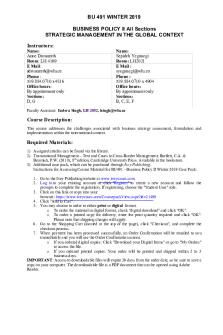Corporate CSR Policy II PDF

| Title | Corporate CSR Policy II |
|---|---|
| Course | Corporate Strategy |
| Institution | NEOMA Business School |
| Pages | 2 |
| File Size | 92 KB |
| File Type | |
| Total Downloads | 73 |
| Total Views | 131 |
Summary
Corporate CSR Policy II...
Description
CORPORATE CSR POLICY: STAKES AND STRATEGIES Direct and indirect impacts Direct impacts: generated by the company’s operations. They fall under its direct liability. Indirect impacts: generated by other companies or actors that: Contribute to the product’s manufacture. Participate in the distribution and consumption of the product and its fate after consumption. Sphere of influence: « Area where, by its political, contractual or economic relationships, a company is able to affect the decisions or activities of companies, organizations or individuals. » Area of power: the company's ability to guide the behavior and activity of other actors, without jeopardizing their legal autonomy. Synthesis: -
The analysis of impacts must focus on the negative impacts generated by the company's activity.
-
Indirect impacts are to be included as soon as the company has a strong influence on its value chain (suppliers, subcontractors, customers, consumers, subsidiaries, etc.)
1. DESIGNING A SOUND CSR POLICY CSR: a strategy CSR policy: impacts and stakeholders
Identifying its impacts:
Use a comprehensive framework (best choice: ISO 26000) Go beyond the direct impacts, by considering: – all the inputs – the whole value chain – consumer use and product end of life
Hear (all) the stakeholders, even (and especially) if they voice tough critics
Selecting the impacts on which to take action:
Impacts generarating heavy negative consequences on many stakeholders Other criteria o o o o
Image, lawsuits or future regulation risks in case of inaction? Known methods for prevention, reduction or mitigation? Costs and delays of action? Impacts of actions on the corporate business model, revenues and profit?
Material analysis: Method for selecting the CSR/DD issues that the company will deal within its strategy, in order to: - Focus its efforts on the most important issues. - Not wasting time or resources on minor issues. Materiality matrix Plots the CSR/DD issues according to their respective importance to stakeholders and the company. It therefore allows to select the issues that will be considered by the company in its CSR strategy. If published, the matrix provides transparency on the choices made by the company....
Similar Free PDFs

Corporate CSR Policy II
- 2 Pages

CSR - csr
- 4 Pages

BU 491 - Policy II Syllabus
- 6 Pages

Corporate Finance CFA Level II
- 12 Pages

Corporate Finance CFA Level II
- 17 Pages
Popular Institutions
- Tinajero National High School - Annex
- Politeknik Caltex Riau
- Yokohama City University
- SGT University
- University of Al-Qadisiyah
- Divine Word College of Vigan
- Techniek College Rotterdam
- Universidade de Santiago
- Universiti Teknologi MARA Cawangan Johor Kampus Pasir Gudang
- Poltekkes Kemenkes Yogyakarta
- Baguio City National High School
- Colegio san marcos
- preparatoria uno
- Centro de Bachillerato Tecnológico Industrial y de Servicios No. 107
- Dalian Maritime University
- Quang Trung Secondary School
- Colegio Tecnológico en Informática
- Corporación Regional de Educación Superior
- Grupo CEDVA
- Dar Al Uloom University
- Centro de Estudios Preuniversitarios de la Universidad Nacional de Ingeniería
- 上智大学
- Aakash International School, Nuna Majara
- San Felipe Neri Catholic School
- Kang Chiao International School - New Taipei City
- Misamis Occidental National High School
- Institución Educativa Escuela Normal Juan Ladrilleros
- Kolehiyo ng Pantukan
- Batanes State College
- Instituto Continental
- Sekolah Menengah Kejuruan Kesehatan Kaltara (Tarakan)
- Colegio de La Inmaculada Concepcion - Cebu










